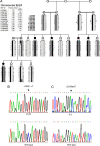Mutations in the very low-density lipoprotein receptor VLDLR cause cerebellar hypoplasia and quadrupedal locomotion in humans
- PMID: 18326629
- PMCID: PMC2393756
- DOI: 10.1073/pnas.0710010105
Mutations in the very low-density lipoprotein receptor VLDLR cause cerebellar hypoplasia and quadrupedal locomotion in humans
Abstract
Quadrupedal gait in humans, also known as Unertan syndrome, is a rare phenotype associated with dysarthric speech, mental retardation, and varying degrees of cerebrocerebellar hypoplasia. Four large consanguineous kindreds from Turkey manifest this phenotype. In two families (A and D), shared homozygosity among affected relatives mapped the trait to a 1.3-Mb region of chromosome 9p24. This genomic region includes the VLDLR gene, which encodes the very low-density lipoprotein receptor, a component of the reelin signaling pathway involved in neuroblast migration in the cerebral cortex and cerebellum. Sequence analysis of VLDLR revealed nonsense mutation R257X in family A and single-nucleotide deletion c2339delT in family D. Both these mutations are predicted to lead to truncated proteins lacking transmembrane and signaling domains. In two other families (B and C), the phenotype is not linked to chromosome 9p. Our data indicate that mutations in VLDLR impair cerebrocerebellar function, conferring in these families a dramatic influence on gait, and that hereditary disorders associated with quadrupedal gait in humans are genetically heterogeneous.
Conflict of interest statement
The authors declare no conflict of interest.
Figures



Comment in
-
Genes and quadrupedal locomotion in humans.Proc Natl Acad Sci U S A. 2008 May 27;105(21):E26. doi: 10.1073/pnas.0802839105. Epub 2008 May 15. Proc Natl Acad Sci U S A. 2008. PMID: 18483196 Free PMC article. No abstract available.
-
"Devolution" of bipedality.Proc Natl Acad Sci U S A. 2008 May 27;105(21):E25. doi: 10.1073/pnas.0802584105. Epub 2008 May 16. Proc Natl Acad Sci U S A. 2008. PMID: 18487453 Free PMC article. No abstract available.
Similar articles
-
Cerebellar hypoplasia, with quadrupedal locomotion, caused by mutations in the very low-density lipoprotein receptor gene.Eur J Hum Genet. 2008 Sep;16(9):1070-4. doi: 10.1038/ejhg.2008.73. Epub 2008 Mar 26. Eur J Hum Genet. 2008. PMID: 18364738
-
A missense founder mutation in VLDLR is associated with Dysequilibrium Syndrome without quadrupedal locomotion.BMC Med Genet. 2012 Sep 14;13:80. doi: 10.1186/1471-2350-13-80. BMC Med Genet. 2012. PMID: 22973972 Free PMC article.
-
Homozygous deletion of the very low density lipoprotein receptor gene causes autosomal recessive cerebellar hypoplasia with cerebral gyral simplification.Am J Hum Genet. 2005 Sep;77(3):477-83. doi: 10.1086/444400. Epub 2005 Jul 22. Am J Hum Genet. 2005. PMID: 16080122 Free PMC article.
-
Unertan syndrome: review and report of four new cases.Int J Neurosci. 2008 Feb;118(2):211-25. doi: 10.1080/00207450701667808. Int J Neurosci. 2008. PMID: 18205078 Review.
-
X-linked disorders with cerebellar dysgenesis.Orphanet J Rare Dis. 2011 May 15;6:24. doi: 10.1186/1750-1172-6-24. Orphanet J Rare Dis. 2011. PMID: 21569638 Free PMC article. Review.
Cited by
-
Uner tan syndrome: history, clinical evaluations, genetics, and the dynamics of human quadrupedalism.Open Neurol J. 2010 Jul 16;4:78-89. doi: 10.2174/1874205X01004010078. Open Neurol J. 2010. PMID: 21258577 Free PMC article.
-
Homozygous Mutations in TBC1D23 Lead to a Non-degenerative Form of Pontocerebellar Hypoplasia.Am J Hum Genet. 2017 Sep 7;101(3):441-450. doi: 10.1016/j.ajhg.2017.07.015. Epub 2017 Aug 17. Am J Hum Genet. 2017. PMID: 28823706 Free PMC article.
-
Lipoprotein receptors--an evolutionarily ancient multifunctional receptor family.Biol Chem. 2010 Nov;391(11):1341-63. doi: 10.1515/BC.2010.129. Biol Chem. 2010. PMID: 20868222 Free PMC article. Review.
-
Modifications of the locomotor system in habitually quadrupedal humans.J Anat. 2022 Sep;241(3):765-775. doi: 10.1111/joa.13693. Epub 2022 Jun 6. J Anat. 2022. PMID: 35661351 Free PMC article.
-
Two families with quadrupedalism, mental retardation, no speech, and infantile hypotonia (Uner Tan Syndrome Type-II); a novel theory for the evolutionary emergence of human bipedalism.Front Neurosci. 2014 Apr 22;8:84. doi: 10.3389/fnins.2014.00084. eCollection 2014. Front Neurosci. 2014. PMID: 24795558 Free PMC article. Review.
References
-
- Spoor F, Wood B, Zonneveld F. Nature. 1994;369:645–648. - PubMed
-
- Richmond BG, Strait DS. Nature. 2000;404:382–385. - PubMed
-
- Bramble DM, Lieberman DE. Nature. 2004;432:345–352. - PubMed
-
- Alemseged Z, Spoor F, Kimbel WH, Bobe R, Geraads D, Reed D, Wynn JG. Nature. 2006;443:296–301. - PubMed
-
- Wood B. Nature. 2006;443:278–281. - PubMed
Publication types
MeSH terms
Substances
LinkOut - more resources
Full Text Sources
Medical
Miscellaneous

